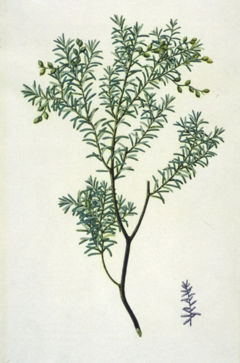Prumnopitys taxifolia: Difference between revisions
imported>Wahib Frank (changing taxobox and IUCN reference) |
imported>John Stephenson (Category) |
||
| Line 30: | Line 30: | ||
* Conifer Specialist Group (1998) id=42541 ''Prumnopitys taxifolia'' 2006 IUCN Red List of Threatened Species. ''IUCN2006'' retrieved on 12 May 2006 | * Conifer Specialist Group (1998) id=42541 ''Prumnopitys taxifolia'' 2006 IUCN Red List of Threatened Species. ''IUCN2006'' retrieved on 12 May 2006 | ||
*[http://www.conifers.org/po/pr/taxifolia.htm Gymnosperm Database: ''Prumnopitys taxifolia'' description] | *[http://www.conifers.org/po/pr/taxifolia.htm Gymnosperm Database: ''Prumnopitys taxifolia'' description] | ||
[[Category: Biology Workgroup]] | |||
Revision as of 00:19, 23 June 2007
| Prumnopitys taxifolia | ||||||||||||||
|---|---|---|---|---|---|---|---|---|---|---|---|---|---|---|
 1780 illustration in the Natural History Museum, London
| ||||||||||||||
| Conservation status | ||||||||||||||
|
least concern
| ||||||||||||||
| Scientific classification | ||||||||||||||
| ||||||||||||||
| Binomial name | ||||||||||||||
| Prumnopitys taxifolia (Banks & Sol. ex D. Don) de Laub. |
Prumnopitys taxifolia (Mataī) is an endemic New Zealand coniferous tree.
It grows up to 40m high, with a trunk up to two metres in diameter. The leaves are linear to sickle-shaped, 10 to 15mm long and 1.5-2mm broad. The seed cones are highly modified, reduced to a central stem 30-40 mm long bearing 1 to 6 scales, each scale maturing berry-like, 10-15 mm long, violet-purple with a soft edible pulp covering the single seed. The seeds are dispersed by the Kererū (New Zealand Pigeon), which eats the 'berries' and passes the seeds in its droppings.
It is distinguished from the related Miro (Prumnopitys ferruginea) by the shorter, slenderer leaves and the globose violet-purple cones.
The scientific name taxifolia derives from the resemblance of the leaves to those of the yew (Taxus). In the past the species, like the other species of Prumnopitys, was often included in Podocarpus; in this species under the name Podocarpus spicatus.
The timber of this tree was used extensively in New Zealand for flooring during the mid-20th century.
References and external links
- Conifer Specialist Group (1998) id=42541 Prumnopitys taxifolia 2006 IUCN Red List of Threatened Species. IUCN2006 retrieved on 12 May 2006
- Gymnosperm Database: Prumnopitys taxifolia description